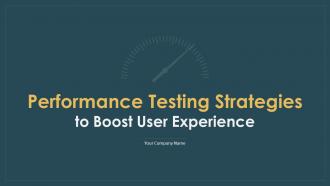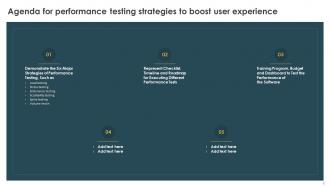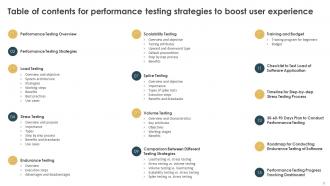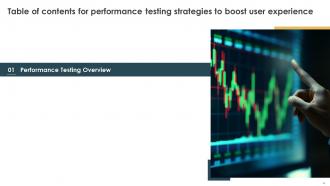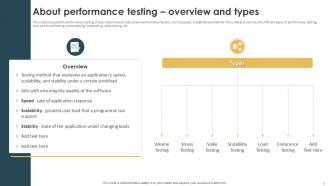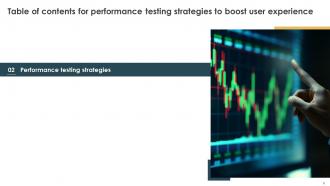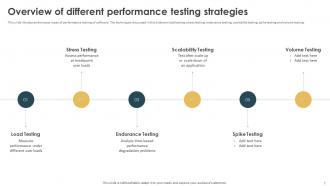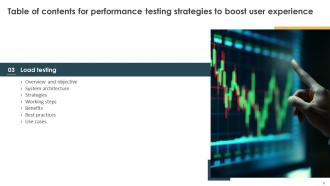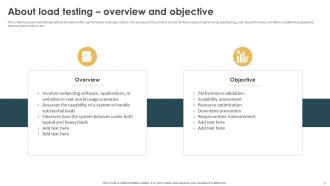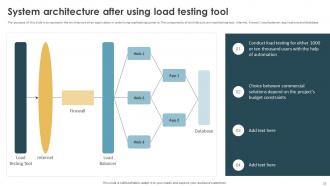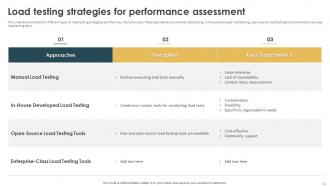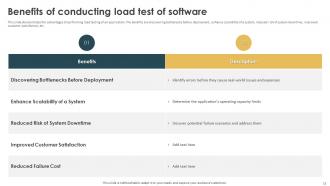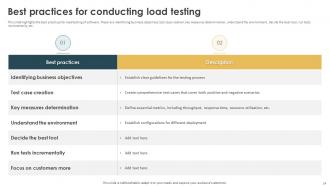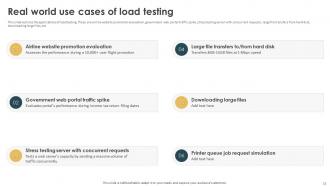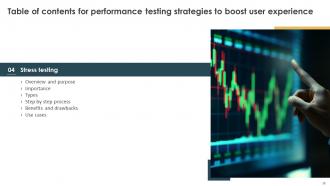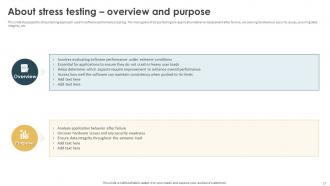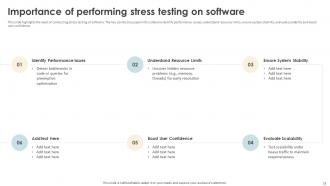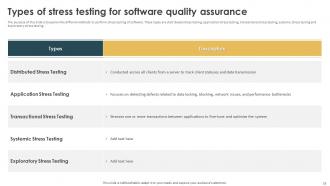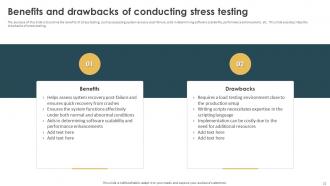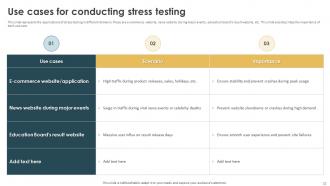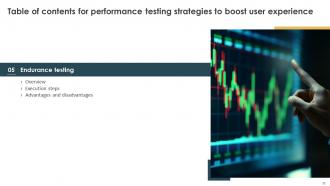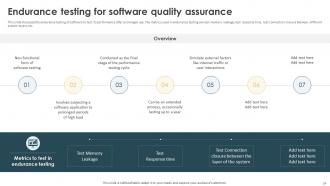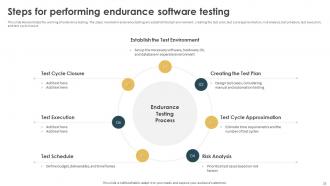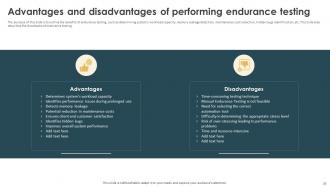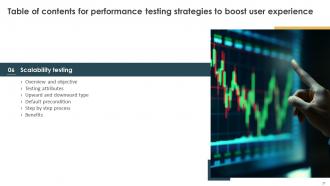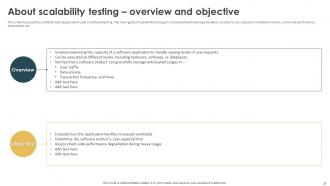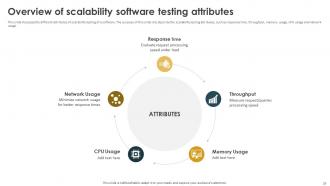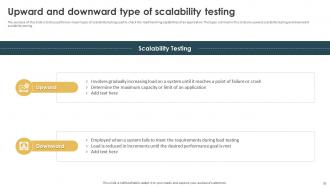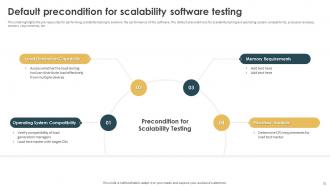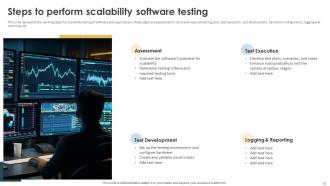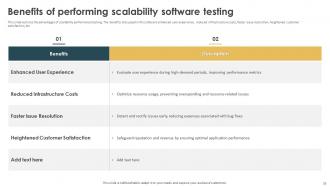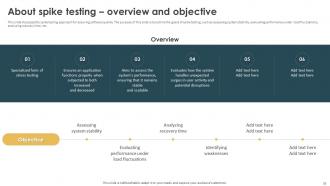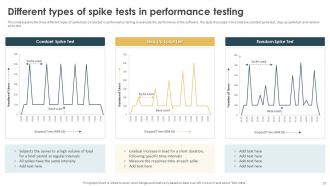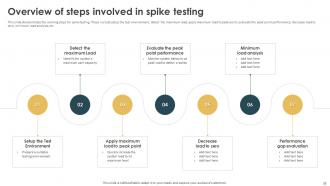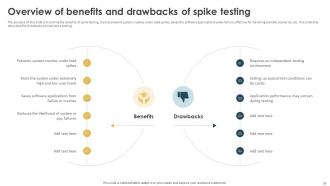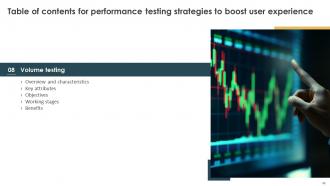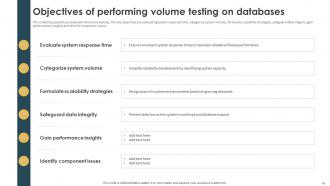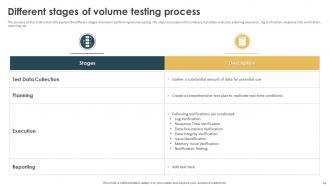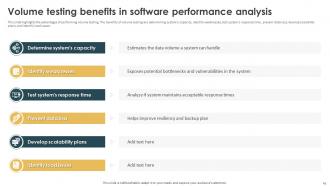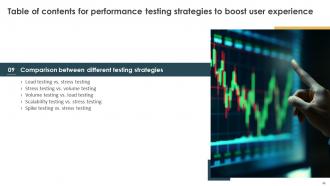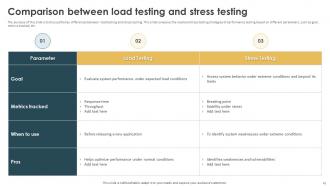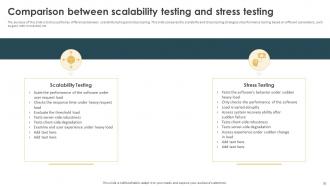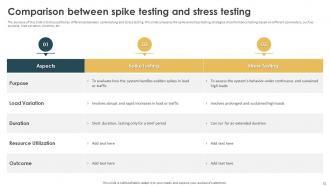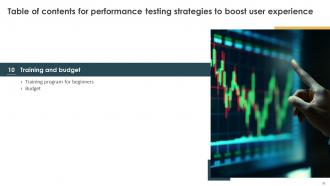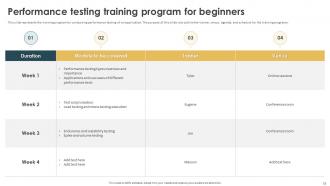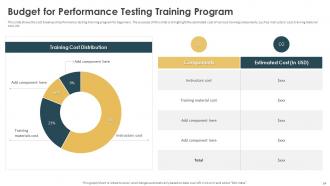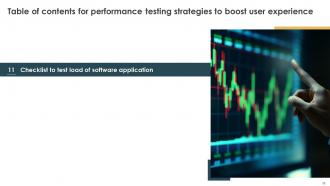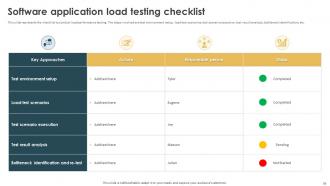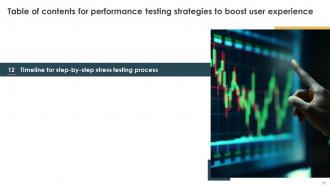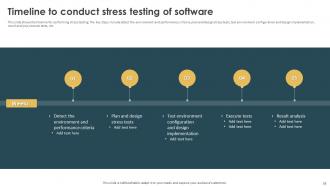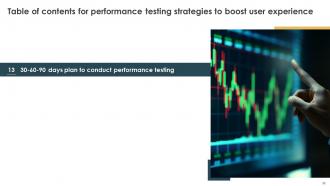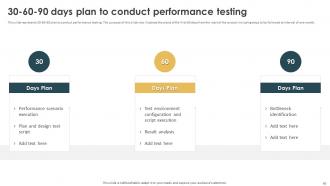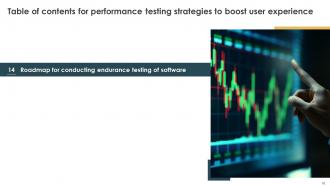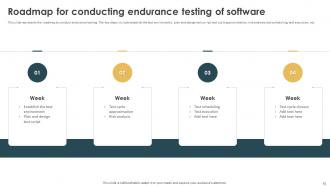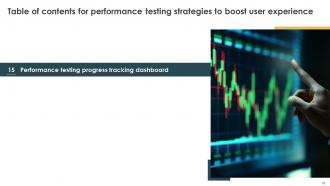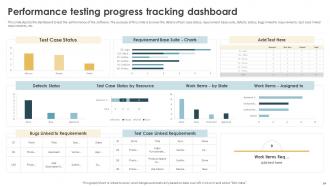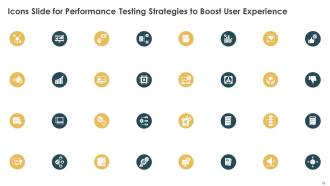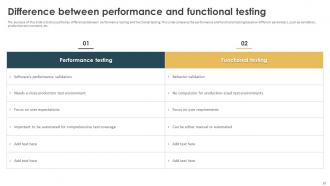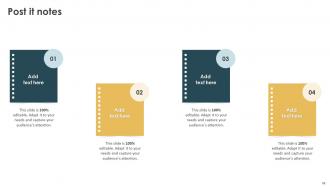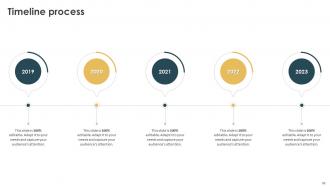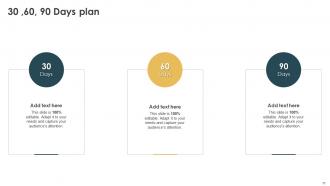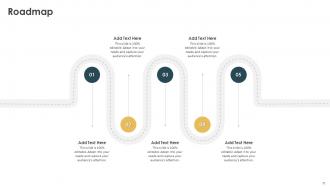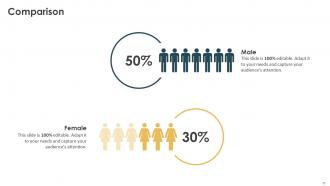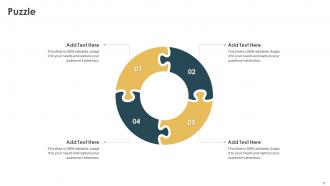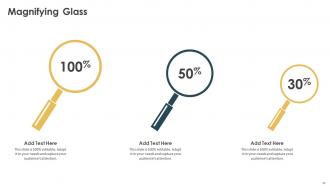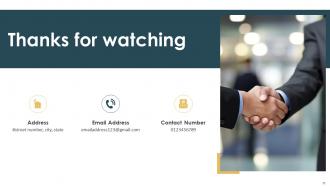Performance Testing Strategies To Boost User Experience Powerpoint Presentation Slides
This performance testing strategies to boost user experience PPT discusses the major types of software performance testing, such as load testing, stress testing, endurance testing, scalability testing, spike testing, and volume testing. In addition, the website performance validation strategies module demonstrates the different types of load testing strategies and their key characteristics. These approaches are manual load testing, in-house developed load testing, open-source load testing tools, and enterprise-class load testing tools. Furthermore, load testing to elevate application excellence PPT discusses the importance, types, step-by-step process, benefits, and use cases of stress testing. It also outlines the attributes of scalability testing, such as response time, throughput, memory usage, CPU usage, and network usage. Moreover, this stress testing approach for superior software provides insights about constant, step-up, and random spike tests, along with an overview of the steps involved in conducting these spike tests. Lastly, this performance testing strategies to boost user experience deck comprises a training program, budget, checklist, roadmap, 30-60-90 plan, and timeline for conducting different types of performance tests of a web application and a dashboard to check the status of performance test execution. Download our 100 percent editable and customizable template, which is also compatible with Google Slides.
You must be logged in to download this presentation.
PowerPoint presentation slides
This complete presentation has PPT slides on wide range of topics highlighting the core areas of your business needs. It has professionally designed templates with relevant visuals and subject driven content. This presentation deck has total of seventy five slides. Get access to the customizable templates. Our designers have created editable templates for your convenience. You can edit the color, text and font size as per your need. You can add or delete the content if required. You are just a click to away to have this ready-made presentation. Click the download button now.
People who downloaded this PowerPoint presentation also viewed the following :
Content of this Powerpoint Presentation
Slide 1: This slide introduces Performance Testing Strategies to Boost User Experience. State your company name and begin.
Slide 2: This is an Agenda slide. State your agendas here.
Slide 3: This slide shows Table of Content for the presentation.
Slide 4: This slide shows title for topics that are to be covered next in the template.
Slide 5: This slide discusses the performance testing of application to evaluate certain performance factors, such as speed, scalability and stability.
Slide 6: This slide shows title for topics that are to be covered next in the template.
Slide 7: This slide introduces the major types of performance testing of software. The techniques discussed in this slide are load testing, stress testing, endurance testing etc.
Slide 8: This slide shows title for topics that are to be covered next in the template.
Slide 9: This slide discusses load testing method to examine the performance of an application. This slide outline the purpose of performing load testing.
Slide 10: This slide represents the architecture of an application in underlying load testing scenario. The components of architecture are load testing tool, internet, firewall etc.
Slide 11: This slide demonstrates the different types of load testing strategies and their key characteristics. These approaches are manual load testing and more.
Slide 12: This slide outlines the steps involved in load testing of an application. These are test environment setup, load test scenarios, test scenario execution etc.
Slide 13: This slide demonstrates the advantages of performing load testing of an application. The benefits are discovering bottlenecks before deployment and more.
Slide 14: This slide highlights the best practices for load testing of software. These are identifying business objectives, test case creation, key measures determination etc.
Slide 15: This slide outlines the applications of load testing. These are airline website promotion evaluation, government web portal traffic spike etc.
Slide 16: This slide shows title for topics that are to be covered next in the template.
Slide 17: This slide discusses the stress testing approach used in software performance testing. The main goals of stress testing are application behavior assessment after failure and more.
Slide 18: This slide highlights the need of conducting stress testing of software. The key points discussed in this slide are identify performance issues, understand resource limits etc.
Slide 19: This slide explains the different methods to perform stress testing of software. These types are distributed stress testing, application stress testing etc.
Slide 20: This slide represents the working steps of stress testing. These steps are detecting the environment, find performance criteria, plan and design stress tests etc.
Slide 21: This slide outlines the benefits of stress testing, such as assessing system recovery post-failure, aids in determining software scalability, performance enhancement, etc.
Slide 22: This slide represents the applications of stress testing in different domains. These are e-commerce website, news website during major events etc.
Slide 23: This slide shows title for topics that are to be covered next in the template.
Slide 24: This slide discusses the endurance testing of software to test its performance after prolonged use. The metrics used in endurance testing are test memory leakage etc.
Slide 25: This slide demonstrates the working of endurance testing. The steps involved in endurance testing are establish the test environment, creating the test plan etc.
Slide 26: This slide outlines the benefits of endurance testing, such as determining system’s workload capacity, memory leakage detection, maintenance cost reduction etc.
Slide 27: This slide shows title for topics that are to be covered next in the template.
Slide 28: This slide discusses the scalability testing approach used in software testing. The main goals of scalability testing are increased load handling evaluation and more.
Slide 29: This slide presents the different attributes of scalability testing of a software. This slide describe the scalability testing attributes, such as response time etc.
Slide 30: This slide discuss the two major types of scalability testing used to check the load handling capabilities of an application.
Slide 31: This slide highlights the pre-requisites for performing scalability testing to examine the performance of the software.
Slide 32: This slide represents the working steps for scalability testing of software and applications. These steps are assessment criteria and required testing tools etc.
Slide 33: This slide outlines the advantages of scalability performance testing. The benefits discussed in this slide are enhanced user experience, reduced infrastructure costs etc.
Slide 34: This slide shows title for topics that are to be covered next in the template.
Slide 35: This slide discusses the spike testing approach for assuring software quality. This slide outline the goals of spike testing, such as assessing system stability etc.
Slide 36: This slide describes the role of spike testing in different scenarios. The spike performance testing can be conducted in various contexts.
Slide 37: This slide explains the three different types of spike tests conducted in performance testing to evaluate the performance of the software.
Slide 38: This slide demonstrates the working steps for spike testing. These include setup the test environment, detect the maximum load, apply maximum load to peak point etc.
Slide 39: This slide outline the benefits of spike testing, such as prevent system crashes under load spikes, saves the software applications under failure etc.
Slide 40: This slide shows title for topics that are to be covered next in the template.
Slide 41: This slide discusses the volume testing approach for assessing database performance. This slide outline the characteristics of volume testing.
Slide 42: This slide highlights the major components tested during volume testing. These attributes are system response time, data integrity, data accuracy, data protection, etc.
Slide 43: This slide discusses the purpose behind volume testing. The key objectives are evaluating system response time, categorize system volume, formulate scalability strategies etc.
Slide 44: This slide briefly explain the different stages involved in performing volume testing. The steps discussed in this slide are, test data collection, planning etc.
Slide 45: This slide highlights the advantages of performing volume testing. The benefits of volume testing are determining system’s capacity, identify weaknesses etc.
Slide 46: This slide shows title for topics that are to be covered next in the template.
Slide 47: This slide discuss the key differences between load testing and stress testing. This slide compares the load and stress testing strategies of performance testing.
Slide 48: This slide displays the key differences between stress testing and volume testing. This slide compares the stress and volume testing strategies of performance testing.
Slide 49: This slide discuss the key differences between volume testing and load testing. This slide compares the volume and load testing strategies of performance testing.
Slide 50: This slide also discuss the key differences between scalability testing and stress testing. This slide compares the scalability and stress testing strategies.
Slide 51: This slide discuss the key differences between spike testing and stress testing. This slide compares the spike and stress testing strategies of performance testing.
Slide 52: This slide shows title for topics that are to be covered next in the template.
Slide 53: This slide represents the training program for conducting performance testing of an application. This slide outline the trainer, venue, agenda and more.
Slide 54: This slide shows the cost breakup of performance testing training program for beginners. This slide highlight the estimated cost of various training components.
Slide 55: This slide shows title for topics that are to be covered next in the template.
Slide 56: This slide represents the checklist to conduct load performance testing. The steps involved are test environment setup, load test scenarios, test scenario execution etc.
Slide 57: This slide shows title for topics that are to be covered next in the template.
Slide 58: This slide displays the timeline for performing stress testing. The key steps include detect the environment and performance criteria, plan and design stress tests etc.
Slide 59: This slide shows title for topics that are to be covered next in the template.
Slide 60: This slide represents 30-60-90 plan to conduct performance testing. This slide illustrate the plans of the first 90 days from the start of the project including steps to be followed at interval of one month.
Slide 61: This slide shows title for topics that are to be covered next in the template.
Slide 62: This slide represents the roadmap to conduct endurance testing. The key steps include establish the test environment, plan and design test script etc.
Slide 63: This slide shows title for topics that are to be covered next in the template.
Slide 64: This slide depicts the dashboard to test the performance of the software. This slide cover the details of test case status, requirement base suite, defects status etc.
Slide 65: This slide shows all the icons included in the presentation.
Slide 66: This slide is titled as Additional Slides for moving forward.
Slide 67: This slide discuss the key differences between performance testing and functional testing. This slide compares the performance and functional testing.
Slide 68: This slide shows Post It Notes for reminders and deadlines. Post your important notes here.
Slide 69: This is a Timeline slide. Show data related to time intervals here.
Slide 70: This slide provides 30 60 90 Days Plan with text boxes.
Slide 71: This slide presents Roadmap with additional textboxes. It can be used to present different series of events.
Slide 72: This is a Comparison slide to state comparison between commodities, entities etc.
Slide 73: This slide contains Puzzle with related icons and text.
Slide 74: This slide showcases Magnifying Glass to highlight, minute details, information, specifications etc.
Slide 75: This is a Thank You slide with address, contact numbers and email address.
Performance Testing Strategies To Boost User Experience Powerpoint Presentation Slides with all 84 slides:
Use our Performance Testing Strategies To Boost User Experience Powerpoint Presentation Slides to effectively help you save your valuable time. They are readymade to fit into any presentation structure.
-
Very unique and reliable designs.
-
Thank you for showering me with discounts every time I was reluctant to make the purchase.






















































































